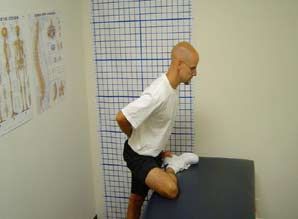How many times per shift do you step in and out of the truck? How many times a day do you squat down? How many times a day do you take a knee on the ground to treat a patient?
A conservative count would be in the hundreds and that can be a lot of strain on the knee. In the last few injury prevention classes I taught a common theme appeared: Most responders do not have adequate flexibility or mobility to perform these repetitive and job specific motions safely.
With the knee competition at a close second to the back as the most injured body part in public safety, we should take a good look at how to prevent and even pre-habilitate some knee issues.
Without going into a complicated rant on patella-femoral kinematics, which bores me too, let’s make this easy to grasp.
The knee is a victim in most cases — tight hip flexors and hamstrings, weak glutes and tight iliotibial bands (IT band) essentially manipulate the knee to move in a way it was not designed to.
A tight ITB for example causes a lateral pull across the joint, discomfort is felt medially but the problem is actually on the outside of the leg. This can occur from prolonged sitting, standing, too much or too little exercise.
Weakness in the gluteal muscles and tightness in the hip flexors can cause a quadriceps dominance, this over firing of the quad muscles places extra strain on the knee joint which can wear the joint down or cause altered mechanics leading to injury. Sitting for long periods, a staple in public safety, will cause the glutes to weaken and the hip flexor to shorten causing what was described above.
The take home message is that your job requires that you are able to step up and down, squat and kneel frequently. There are three keys to ensuring that your career is a long and healthy one.
1) Stability: The ability to brace your core and stiffen your spine rapidly to maintain balance and protect your joints.
2) Mobility: The ability for muscles to move freely unencumbered by scar tissue or trigger points.
3) Flexibility: The ability for your musculoskeletal system to move through a normal range of motion.
Stability has been covered in previous articles and I strongly encourage you to read them and understand how important it is to master that technique.
Mobility is the ability for your muscles to move freely and unrestricted. Unfortunately most of us are full of trigger points that restrict and change how a muscle moves. A trigger point is described as hyperirritable spots in skeletal muscle that are associated with palpable nodules in taut bands of muscle fibers.
Trigger points do not stretch very much so achieving adequate tissue mobility in the presence of trigger points takes some pressure. Pressure can come in the form of a massage or even better, a self massage. A tennis ball is an awesome tool to break up trigger points in the muscles. Simply place the tennis ball on the trigger point and hold pressure for 30 seconds. As I teach in my seminars, healthy tissue does not hurt, search for the spots that hurt the most and hold pressure there.
|
The glutes, side of the leg, upper-middle and lower back are all common areas to address. Two times a week while watching TV between calls for about 15 minutes each time will yield improved mobility, drastically reducing your chance of injury and making your job easier.
The last facet of a healthy knee is to have sufficient flexibility in the ankle/knee/hip. Most responders do not sustain an injury from the knee being “tight.” The injurious mechanics occur when the ankle, quadriceps, hamstring, glutes and the iliotibial band become tight and or weak. A discussion on tightness-weakness is beyond the scope of this article and frankly will put most of you to sleep. If still curious, go to www.humankinetics.com for more info.
|
As I have stated many times in previous articles, a career in public safety lends to a series of predictable and very dangerous postural and mechanical distortions. Specifically tight hip flexors, hamstrings, calves and lower back and weak glutes and abdominal wall.
|
The take home message here is to stretch your hip flexors, glutes and hamstrings sporadically throughout the day. As I teach my crews, longer is better and less is more. Hold a stretch for 60 seconds, and stretching should be uncomfortable but not painful.
|
The cool part of mobility and flexibility is they help each other out. If you have trouble getting into a proper stretch position, self massage it and I guarantee you it’s easier to stretch which means you move better which means your knee has less strain on it. It’s just that easy, now go get a tennis ball and get to work, besides you’re just sitting there watching TV anyway.
















